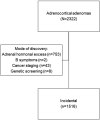Clinical and imaging presentations are associated with function in incidental adrenocortical adenomas: a retrospective cohort study
- PMID: 38941271
- PMCID: PMC11234193
- DOI: 10.1093/ejendo/lvae078
Clinical and imaging presentations are associated with function in incidental adrenocortical adenomas: a retrospective cohort study
Abstract
Objective: The aim of this study is to assess whether clinical and imaging characteristics are associated with the hormonal subtype, growth, and adrenalectomy for incidental adrenal cortical adenomas (ACAs).
Design: This is a single-center cohort study.
Methods: Consecutive adult patients with incidental ACA were diagnosed between 2000 and 2016.
Results: Of the 1516 patients with incidental ACA (median age 59 years, 62% women), 699 (46%) had nonfunctioning adenomas (NFAs), 482 (31%) had mild autonomous cortisol secretion (MACS), 62 (4%) had primary aldosteronism (PA), 39 (3%) had Cushing syndrome, 18 (1%) had PA and MACS, and 226 (15%) had incomplete work-up. Age, sex, tumor size, and tumor laterality, but not unenhanced computed tomography Hounsfield units (HU), were associated with hormonal subtypes. In a multivariable analysis, ≥1 cm growth was associated with younger age (odds ratio [OR] = 0.8 per 5-year increase, P = .0047) and longer imaging follow-up (OR = 1.2 per year, P < .0001). Adrenalectomy was performed in 355 (23%) patients, including 38% of MACS and 15% of NFA. Adrenalectomy for NFA and MACS was more common in younger patients (OR = 0.79 per 5-year increase, P = .002), larger initial tumor size (OR = 2.3 per 1 cm increase, P < .0001), ≥1 cm growth (OR = 15.3, P < .0001), and higher postdexamethasone cortisol (OR = 6.6 for >5 vs <1.8 μg/dL, P = .002).
Conclusions: Age, sex, tumor size, and laterality were associated with ACA hormonal subtype and can guide diagnosis and management. Tumor growth was more common with younger age and longer follow-up. Unenhanced HU did not predict hormonal subtype or growth. Adrenalectomy for MACS and NFA was mainly performed in younger patients with larger tumor size, growth, and elevated postdexamethasone cortisol.
Keywords: Cushing syndrome; adrenal incidentaloma; adrenal mass; adrenal neoplasm; adrenal tumor; diagnosis; mild autonomous cortisol secretion; nonfunctioning adrenal tumor; primary aldosteronism.
© The Author(s) 2024. Published by Oxford University Press on behalf of European Society of Endocrinology. All rights reserved. For commercial re-use, please contact reprints@oup.com for reprints and translation rights for reprints. All other permissions can be obtained through our RightsLink service via the Permissions link on the article page on our site—for further information please contact journals.permissions@oup.com.
Conflict of interest statement
Conflict of interest: I.B. reports consulting or advisory board participation with Corcept Therapeutics, HRA Pharma, Sparrow Pharmaceuticals, Recordati Rare Diseases, Neurocrine Biosciences, Diurnal, Sparrow, Novo Nordisk, AstraZeneca, Xeris, and Adrenas outside the submitted work and reports funding from Recordati and HRA Pharma outside this work. I.B. is on the editorial board of EJE. She was not involved in the review or editorial process for this paper, on which she is listed as coauthor. O.H. reports advisory board participation with Corcept Therapeutics, Recordati Rare Diseases, Amryt Pharma, Xeris, Lantheus, and Neurocrine Biosciences outside the submitted work. D.L. is currently an employee of BridgeBio Pharma, which is unrelated to the submitted work.
Figures
References
MeSH terms
Substances
Grants and funding
LinkOut - more resources
Full Text Sources
Miscellaneous



